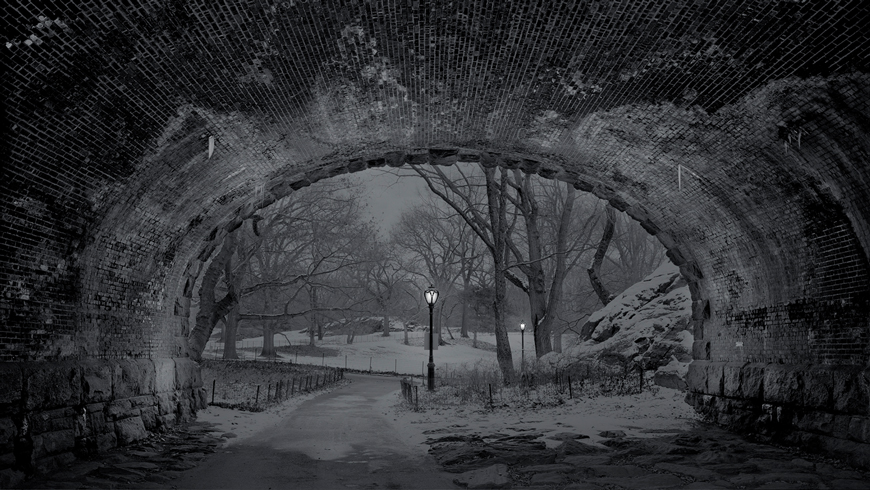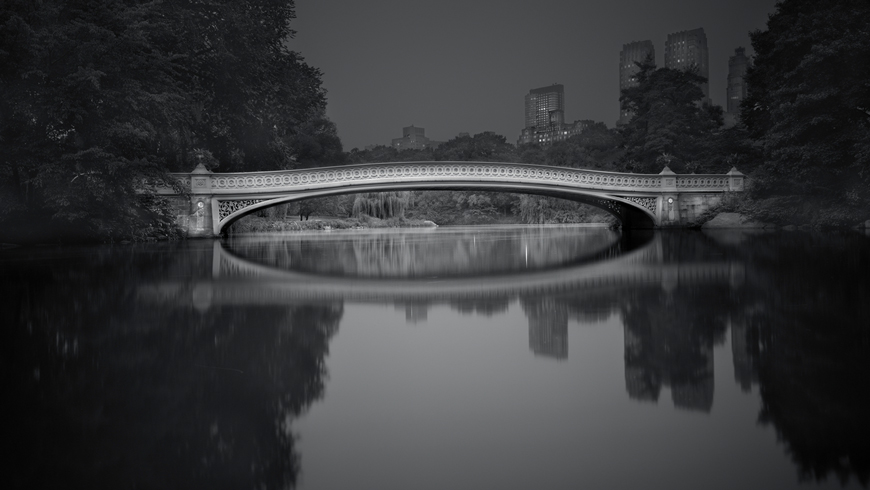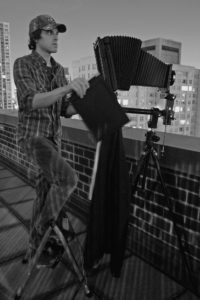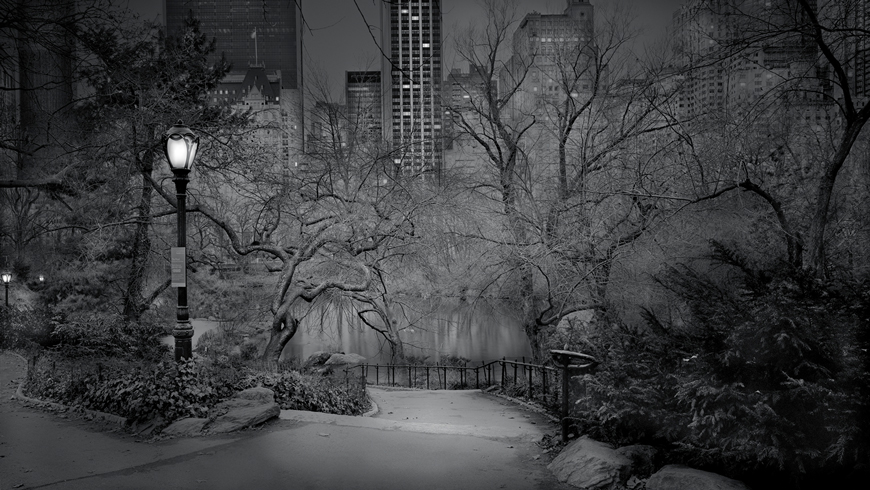… The smoke makes a stairway for you to descend;
You come to my arms, may this bliss never end,
For we love anew just as we used to do
When I’m deep in a dream of you …
—“Deep in a Dream” by Frank Sinatra
“Deep in a Dream,” a seductive series of images named for a sexy Sinatra song and currently on exhibit at Gilman Contemporary in Ketchum, was shot over a decade in New York City’s Central Park by photographer Michael Massaia. The project began as most of Michael Massaia’s work has, usually after midnight, when he slung on his black backpack and forged into the darkness with his tripod, camera, and black and white sheet film.
The path he followed from his New Jersey home to Manhattan’s most famous green space was a nightly walk to combat insomnia. For him now, sleep is just a hindrance to the creative process, the foundation of which begins between 2 and 6 a.m., when the majority of New York City is asleep.
“Sixty blocks of complete emptiness. Five miles of just nothing,” he recalled. “Everything is faint and there is great ambient city noise. Everything is at bay. It’s almost theatrical.”
In that cusp between dusk and dawn, Massaia found his wide awake dreams.
Standing before one of his images is like witnessing a theatrical set during a technical rehearsal. Although frozen in the instant of a shutter snap, the images are alive with light and movement, even in the absence of human forms, who do make an occasional, oblivious appearance. It feels like something is about
to happen.

“Eaglevale Arch Looking North” by Michael Massaia at Gilman Contemporary, split toned gelatin silver print, 30 in. x 41 in.
What may appear at first to have been staged is really opportunistic planning and a night prowler’s stealth.
“The idea and the aesthetic are the hard part. The imagination is the hard part.”
The park’s arches and bridges, tunnels and paths gave direction, and sometimes refuge from the weather, where he hunkered with his film and fantasy, and those structures then became intimate subjects.
“To me, it’s places that are vacant or forgotten about that mean the most to me,” he explained. “They are the places I connect to, and the times of day when other people don’t like them.”
What he found in the in-between space of Central Park was something operatic, but it would require an enormous amount of patience before he would commit to a moment.
“New York is a city full of artifice, and it is ridiculous in many ways. I had to find the perfect point and the perfect backdrop, a certain building or something in the foreground.
“I wanted it to be borderline artificial because it all really is so perfect. But vacancy was as important as the pieces that were there. If all the parts of the composition were there, it would look fake.
“What’s exciting to me is seeing that I extracted something from the environment that actually feels the way it was captured. It looks like a premeditated scene but it’s actually an extraction of a moment … There is a lot of longing in what I do. A lot of romantic notion. The way I wish it could be all of the time.” As Massaia backs away from an image, the grunt work and perfectionism do not wane.
All but one room of his New Jersey home is dedicated to the process. He puts on some Sinatra, “A Man Alone,” on repeat. He makes the negatives, prints and handmakes the frames. He doesn’t cook, or eat out. He makes a lot of peanut butter and jelly sandwiches. He will sometimes call on his mother or brother for the heavy lifting, or to help hang the dripping prints. The one neighbor who vaguely knows what he does will occasionally return an errant print with a tire tread on it after it has blown over the fence.
Massaia’s self-imposed institutionalization has channeled his agile mind. It is an exacting mind that is equal parts agitant, contrarian, director, dreamer, pessimist, romantic and introvert.
The son of a printmaker, Massaia let his early unease with his environment lead him into a lot of crappy jobs, including cleaning up after imported reptiles passed through an animal hospital.
“I kind of fell off the map for a while,” he admitted. “I’ve always been a malcontent in terms of my environment. The feeling of not being comfortable with the way things are around you usually has to do with the people you are experiencing them with.”

“Bow Bridge-Predawn” by Michael Massaia at Gilman Contemporary, gold toned gelatin silver print, 37 in. x 58 in.
So he eliminated most of the people he had to interact with from his life and stopped resisting who he wasn’t and how he thought. And at 40, the self-taught photographer who has gained renown for mastering the gelatin silver printing process has come closer to a personal and professional reconciliation.
“A lot of the younger people have a huge amount of confidence but they haven’t done anything. There is no inner conflict. I was a complete failure in my 20s, not measuring up, not being good enough. I had a basic feeling of inadequacy that made me want to improve. The people that have meant the most to me were the ones losing sleep and trying to make a bad situation compelling or worthwhile.”
Always artistic, his printing and painting would be compromised in some way that photography was not.

Michael Massaia
“It’s one of the few mediums where you can actually imagine something and you can go do it. It’s like working backwards from a blueprint.”
And the medium gave a formless, ill-fitting life some shape and some control.
“I locked myself in the dark room making huge mistakes and huge failures, but the excitement of being so close to a dream drove me.”
When it came time to craft an artist statement, Massaia found what he wanted to say in the book of Hebrews 11:13-16 that describes a dissonance he could relate to.
“It describes a group of people that for whatever reason never feel like they are at home anywhere on the earth, searching for a home they are never going to find,” he said. “To me that is more profound than anything that I could come up with. The catalyst is in the searching. That helped me find myself. It was something I never knew how to explain. That was the frustration, trying to fight that. Maybe I don’t have to fight it, I’m not supposed to fight it, this is where I’m supposed to be.”


